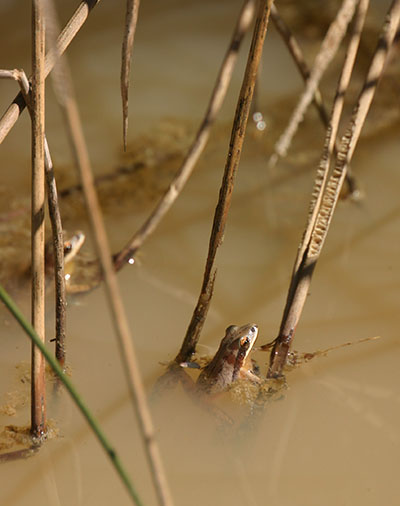 The other day, with the warm weather assuring us that it was here to stay (dishonestly, I must add,) I donned shorts for the first time to meet with a student and go out seeking the first real signs of spring to a nature photographer, which is generally wildlife in search of booty. While I had earlier been hearing the evidence of the critters pictured here, I had yet to go down to their typical lairs, which are small ponds and even puddles surrounded by high grasses. These are likely southern chorus frogs (Pseudagris nigrita nigrita,) though I stand to be corrected – I am using an Audubon Guide for identification, which unfortunately lacks strong descriptions and photos to make firm distinctions; at least three species could fit what you see here, especially when they give markings as “three stripes along back that may be broken into spots.” All likely chorus frogs in this area have spots…
The other day, with the warm weather assuring us that it was here to stay (dishonestly, I must add,) I donned shorts for the first time to meet with a student and go out seeking the first real signs of spring to a nature photographer, which is generally wildlife in search of booty. While I had earlier been hearing the evidence of the critters pictured here, I had yet to go down to their typical lairs, which are small ponds and even puddles surrounded by high grasses. These are likely southern chorus frogs (Pseudagris nigrita nigrita,) though I stand to be corrected – I am using an Audubon Guide for identification, which unfortunately lacks strong descriptions and photos to make firm distinctions; at least three species could fit what you see here, especially when they give markings as “three stripes along back that may be broken into spots.” All likely chorus frogs in this area have spots…
The most distinctive trait of them, however, is reflected in their name. This was nothing more than a large puddle, and at 3 pm they were advertising for mates in their manner, which is a reedy high-pitched vibrating sound. You know you’re closing in on them by the increase in apparent volume, but generally as you get close they see you and stop making any noise at all. We had pinpointed the puddle but took some time to finally spot a few, since they are no more than 3 cm in body length and colored much like the mud and grasses of their habitat. Suffice to say that when I got this photo, I hadn’t even seen the second one to the left.
As we stood there, they decided all at once that we were no threat, and began the chorus again. I don’t have enough experience with them to know for sure what triggers it, but they don’t sound off alone; everyone in the area speaks up, possibly because they’re in competition with one another. There are no false starts, no lone voice ringing out before the others start to chime in – within a second, half a dozen or more frogs are all calling together. When close, the sound is unbelievably penetrating, certainly uncomfortable and making conversation a bit difficult. I regretted not bringing any kind of recorder along with me, but I got plenty of shots of them calling. We’ll get back to this shortly.
In the same puddles scampered a large number of tiny fishing spiders, not even a centimeter in leg spread and mostly a deep reddish brown. As I watched, one set off at high speed across a tire rut filled with water, passing in front of another that was perhaps twice its size, unseen by either of us until it shot out across the water and seized the smaller. We might think of this as cannibalism, but I have no idea if they were the same species or not; we eat mammals ourselves. Not to mention that spiders aren’t a social species, and have no reason to cooperate with each other. Food’s food.
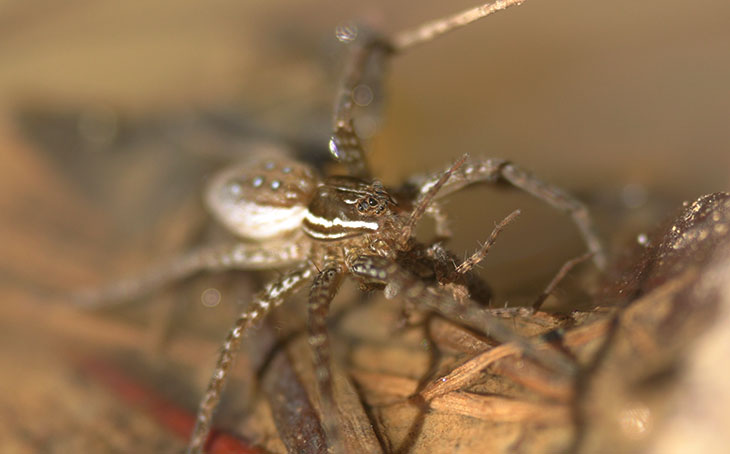
I would have liked this image to be a bit better, but I was shooting in natural light without flash and couldn’t afford to stop down too much, since it would have slowed the shutter speed and my own movement would have ruined the shot. As it was, I was in kneepads, propped on my elbows in the mud at the edge of the puddle, trying not to get my hands filthy. While getting some of the frog pics, I buried my sandals in the mud so thoroughly that I was in imminent danger of leaving them behind, or simply falling over because I couldn’t extract my feet to maintain balance, to the amusement of my student. Nevertheless, that is why I wear them, and to me, getting the shot is worth the mud and inconvenience – they’ve received this spring’s christening.
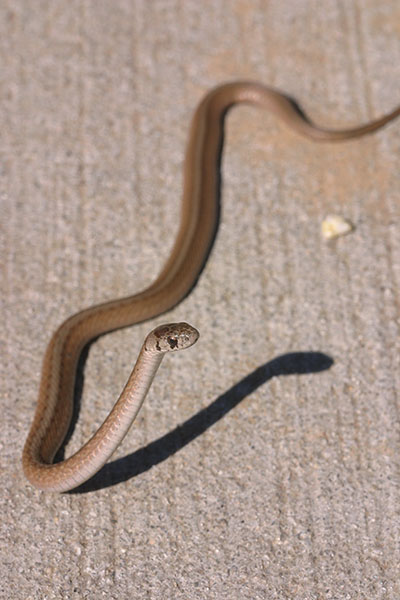 The next day, I was determined to capture the sounds of the chorus frogs, and went to a nearby park that has lots of water basins. The biggest one, that provided some of the action shots from last year, was curiously still – it’s early yet – and while I could hear the frogs sounding in the middle distance, they were never calling at any body of water I came across. Subjects to photograph were so sparse it seemed almost like a total waste of time. It goes like this sometimes, even though I can usually find something to capture.
The next day, I was determined to capture the sounds of the chorus frogs, and went to a nearby park that has lots of water basins. The biggest one, that provided some of the action shots from last year, was curiously still – it’s early yet – and while I could hear the frogs sounding in the middle distance, they were never calling at any body of water I came across. Subjects to photograph were so sparse it seemed almost like a total waste of time. It goes like this sometimes, even though I can usually find something to capture.
Then, a minuscule brown snake (Storeria decayi) that was basking on the concrete path displayed its reluctance to yield, which provided some great poses – there’s no way I should have been able to take as many shots, from as many different angles, as I did. This behavior is often an indication of a recent meal, since snakes need a certain body temperature to maintain digestive energy and will often warm themselves on sunny surfaces in the morning after finding food. Their mobility may be hampered by the mass in their abdomen, but even if not, they would rather stay in the sunlight, so will defend themselves more vigorously than at other times, when diving into the underbrush is their chief defense. However, I spotted no telltale swelling or change in girth at all, so I considered it unlikely in this case; it might have simply been the first time out since the torpor of the winter months. It’s not often that I get to see a raised head pose, and when I do, it is often accompanied by a vibrating tail, the threat display of far more than just rattlesnakes. This is quite impressive, because it’s a blur, and it can make a great drumming sound against a solid surface, but a fiercely creepy rattle in dry leaves – unfortunately, my subject here wasn’t so inclined, nor did it strike at me as I lay on my side right in front of it with the camera.
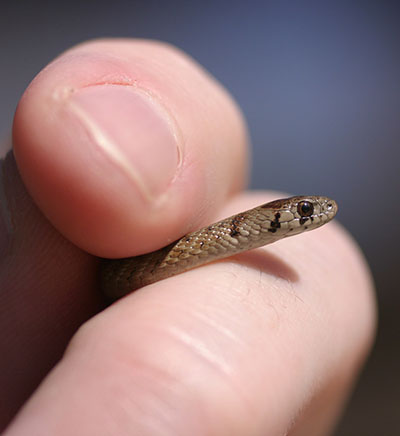 And I can’t let this go without a scale shot. While I’ve seen bigger, brown snakes really aren’t very impressive in size no matter what, though they do outclass the worm snakes.
And I can’t let this go without a scale shot. While I’ve seen bigger, brown snakes really aren’t very impressive in size no matter what, though they do outclass the worm snakes.
Satisfied that the trip produced at least a few shots, I wandered back to the areas with all the water, and this time around, the frogs were calling actively. I had brought along two different audio recorders – my MP3 player with voice memo function, and an old-school microcassette recorder I’ve had for years. I was counting on the MP3 player, since it produced files already in digital format, but despite being right on top of the frogs and practically going deaf, the sound quality was particularly lacking, with a seemingly mechanical backbeat that had to be from within the player. Luckily, the cassette recorder was able to patch between the earphone jack and the Line In port of my sound card, and I recorded the playback through Audacity, which is an excellent free audio recording and mixing program.
Now, the difference between the two days. I was sitting right smack on the edge of a catch basin that was, at most, 2.5 meters across, with numerous frogs sounding off in very close proximity. I’m pretty good (though not perfect) at spotting such critters, especially when they’re announcing their presence at ear-shattering volume. And yet, I did not see one frog at all. They had to be above the surface, and unlike the previous day this water was perfectly clear, and the grasses at the edge were not thick at all, but the frogs maintained perfect concealment. It is entirely possible that this was a haunted puddle, brimming with little tormented amphibian spirits with unfinished business (I’ll leave the speculation of what this could be to you,) but for now, despite the urging of my ego, I’m going to go with their ability to hide being better than my ability to spot them.
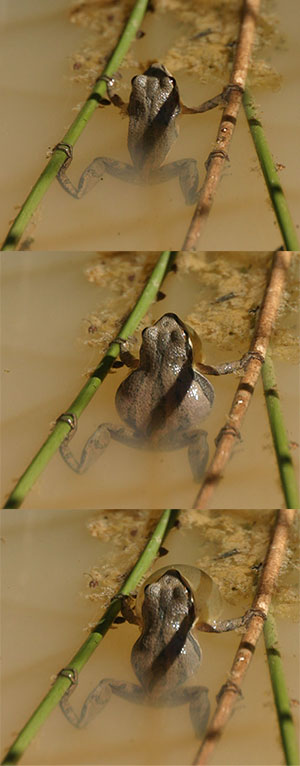 So, as I provide the recording that I made that day, I give you a photo sequence of a frog from the previous day, when I could actually see them. The first pic was ‘at rest,’ as it were, while they were all silent. But imagine the next two alternating regularly during the call – the inflated belly during the silences, with the distended throat sac while emitting that bad-bearing squeak that you can hear by clicking on the tag below. It should be said that there was never the appearance of expelling the air – it simply switched places, being recycled as it were, since the sound is as internal as humming is to us. I had originally tried to produce an animated gif (pronounced “hor-hay”) of this, yet couldn’t get it to appear less than bad claymation and gave it up after playing with it far too long last night. It would undoubtedly be better in true video, but I’ve never bothered to get a digital camcorder and have little enough use for a low-end model – I’d want something that could do serious macro work, but that would require supplemental constant-light sources and a whole lot of playing around for, what, the blog and website? Not justified (no offense.) Anyway, this recording was started as I was a short distance away and approaching, ending up just a few meters from the frogs – the volume is, hopefully, able to express the idea without getting too obtrusive.
So, as I provide the recording that I made that day, I give you a photo sequence of a frog from the previous day, when I could actually see them. The first pic was ‘at rest,’ as it were, while they were all silent. But imagine the next two alternating regularly during the call – the inflated belly during the silences, with the distended throat sac while emitting that bad-bearing squeak that you can hear by clicking on the tag below. It should be said that there was never the appearance of expelling the air – it simply switched places, being recycled as it were, since the sound is as internal as humming is to us. I had originally tried to produce an animated gif (pronounced “hor-hay”) of this, yet couldn’t get it to appear less than bad claymation and gave it up after playing with it far too long last night. It would undoubtedly be better in true video, but I’ve never bothered to get a digital camcorder and have little enough use for a low-end model – I’d want something that could do serious macro work, but that would require supplemental constant-light sources and a whole lot of playing around for, what, the blog and website? Not justified (no offense.) Anyway, this recording was started as I was a short distance away and approaching, ending up just a few meters from the frogs – the volume is, hopefully, able to express the idea without getting too obtrusive.
There is an added bonus in that you can drive the cats nuts with this. Actually, you can drive anyone nuts with this, I suspect…




















































